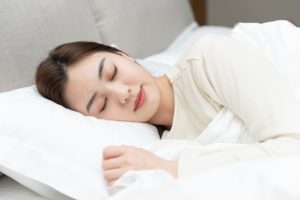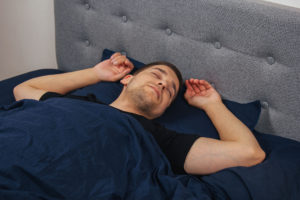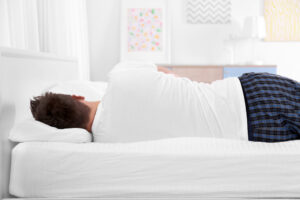What Your Sleep Position Means
Many people have wondered if their preferred sleeping position reveals aspects of their personality. Very little scientific research about sleep positions and personality traits exists, and recent studies find a tenuous connection between the two. Although there is some research linking sleep position and personality , study methods and definitions of different sleeping positions vary widely, and thus far researchers are unable to convincingly explain the logic behind the connection.
Despite the lack of rigorous research on sleep position and personality, contemplating your preferred positions could still be interesting and useful. Research about sleep position can provide helpful insights into your health and sleep, as people often consciously or unconsciously adopt certain sleeping positions to help relieve uncomfortable symptoms.
Is Your Troubled Sleep a Health Risk?
A variety of issues can cause problems sleeping. Answer three questions to understand if it’s a concern you should worry about.
What Does Your Sleeping Position Say About You?
The definition of each sleeping position changes from study to study, but most researchers speak of side, back, and stomach sleeping, and divide each of these broad categories into several variations.
Over time, researchers have posited that different sleeping positions correspond to different personality traits. Since there is no recent peer-reviewed research available to support these claims, they should be taken lightly.
“There is a lack of rigorous research on relationships between sleep and personality traits. It is likely that physical and/or demographic characteristics and medical conditions influence sleeping position.”
Dr. Kara Bagot, Psychiatrist
Fetal
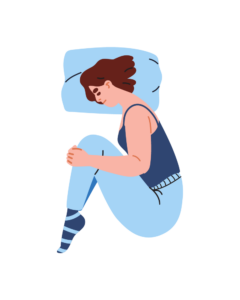
The fetal position gets its name from the shape of a baby in the womb. In the fetal position, a sleeper’s body is essentially curled up into a ball as they lie on one side with legs and arms bent. This position is commonly assumed by adult sleepers. Exact numbers vary, but studies show that on average, over 60% of adults spend the majority of the night in a side position. Older age and a higher body mass index are both associated with more side sleeping .
In the 1970s, sleep researcher Samuel Dunkell was the first to hypothesize that the fetal position corresponded with certain personality characteristics. Through his research, Dunkell observed that fetal position sleepers tend to be more anxious and emotional. This was in contrast to the semi-fetal position, whose adherents he described as being well adjusted.
Log
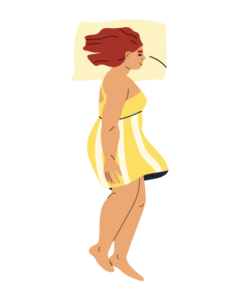
Although the log is another side sleeping position, it differs quite a bit from the fetal position. While assuming a log position, a sleeper has both their arms and legs extended, so their body is straight like a log. Surveys suggest the log as being a common position, while other research suggests that a true log side sleeping position is uncommon. This study found that many sleepers extend both legs while sleeping on their sides, but most keep at least one arm folded.
Sleep scientist Chris Idzikowski claims that preferring a log position suggests that a person is sociable and interacts with others easily. While these are attractive traits, he warns that this openness and willingness to trust could make them gullible.
Yearner
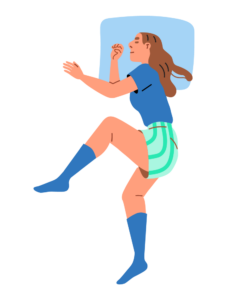
In the yearner position, a sleeper looks like they are reaching or yearning for something. Their legs and arms are both outstretched, like in the log position. The difference is that instead of being by their sides, their arms extend forward. If you sleep in the yearner position and experience shoulder pain , you might want to consider sleeping in a different position.
According to research by Idzikowski, people who prefer the yearner position tend to be open, though not as open as those who prefer the log position. Yearners can also be cynical and suspicious. That said, this research has not yet been peer-reviewed or replicated by other researchers.
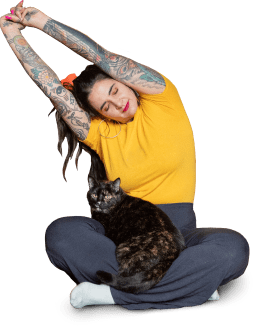
Soldier
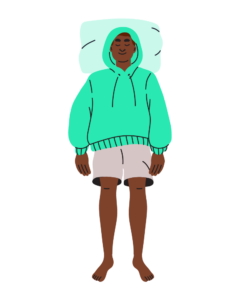
In the soldier position, you lie as straight as a soldier stands. The legs are not bent, and your arms lie straight along the sides of your body. Idzikowski claims soldier sleepers are quiet and reserved, but also hold high standards.
Some individuals may find the soldier position helps alleviate pressure points. Although back sleeping can trigger acid reflux when a person is lying flat, symptoms are reduced in those who sleep on their back with the head of the bed elevated .
Starfish
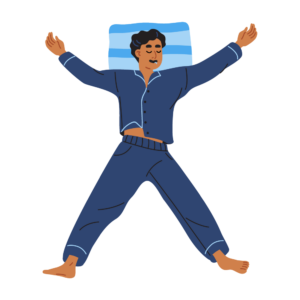
When sleeping like a starfish, you lie on your back with arms up near the pillow and legs outstretched. Idzikowski says starfish sleepers value friendship, and that while they prefer not to be the center of attention, people who sleep in this position are good listeners and quick to help others.
The back sleeping positions are the second most popular positions, after side sleeping. One study found that, on average, over one-third of sleeping time is spent on the back. Based on his 1970s research, sleep researcher Dunkell claimed that people who sleep on their backs are more self-confident. Dunkell also said back sleepers are likely to be more open and sensation-seeking than other sleepers.
Freefall
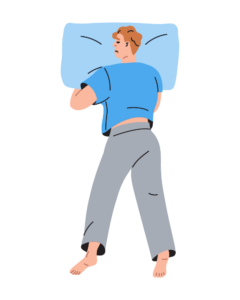
In the freefall position, a stomach sleeper has their hands on or around their pillow, with their head turned to one side. Idzikowski claims his research shows that freefall sleepers are social and can border on being brash. However, they are more sensitive and can become unsettled by criticism or extreme situations.
Of all sleep positions, stomach sleeping is the least popular. Sleep researcher Dunkell posited that stomach sleepers tend to be anxious, impulsive, compulsive, and rigid, traits he said work well for jobs in accounting, banking, and management. Similarly, researchers in 1980 and 2002 found that stomach sleepers were more likely to be anxious and less self-confident.

Still have questions? Ask our community!
Join our Sleep Care Community — a trusted hub of sleep health professionals, product specialists, and people just like you. Whether you need expert sleep advice for your insomnia or you’re searching for the perfect mattress, we’ve got you covered. Get personalized guidance from the experts who know sleep best.
References
6 Sources
-
Kamau, L., Luber, E., & Kumar, V. K. (2012). Sleep positions and personality: Zuckerman-Kuhlman’s big five, creativity, creativity styles, and hypnotizability. North American Journal of Psychology, 14(3), 609–622.
https://www.researchgate.net/publication/287884030_Sleep_positions_and_personality_Zuckerman-Kuhlman%27s_big_five_creativity_creativity_styles_and_hypnotizability -
Sleep position gives personality clue. (2003, September 16). BBC News.
http://news.bbc.co.uk/2/hi/health/3112170.stm -
Cary, D., Briffa, K., & McKenna, L. (2019). Identifying relationships between sleep posture and non-specific spinal symptoms in adults: A scoping review. BMJ Open, 9(6), e027633.
https://pubmed.ncbi.nlm.nih.gov/31256029/ -
Skarpsno, E. S., Mork, P. J., Nilsen, T. I. L., & Holtermann, A. (2017). Sleep positions and nocturnal body movements based on free-living accelerometer recordings: Association with demographics, lifestyle, and insomnia symptoms. Nature and Science of Sleep, 9, 267–275.
https://pubmed.ncbi.nlm.nih.gov/29138608/ -
Zenian, J. (2010). Sleep position and shoulder pain. Medical Hypotheses, 74(4), 639–643.
https://pubmed.ncbi.nlm.nih.gov/20036076/ -
Khan, B. A., Sodhi, J. S., Zargar, S. A., Javid, G., Yattoo, G. N., Shah, A., Gulzar, G. M., & Khan, M. A. (2012). Effect of bed head elevation during sleep in symptomatic patients of nocturnal gastroesophageal reflux. Journal of Gastroenterology and Hepatology, 27(6), 1078–1082.
https://pubmed.ncbi.nlm.nih.gov/22098332/






